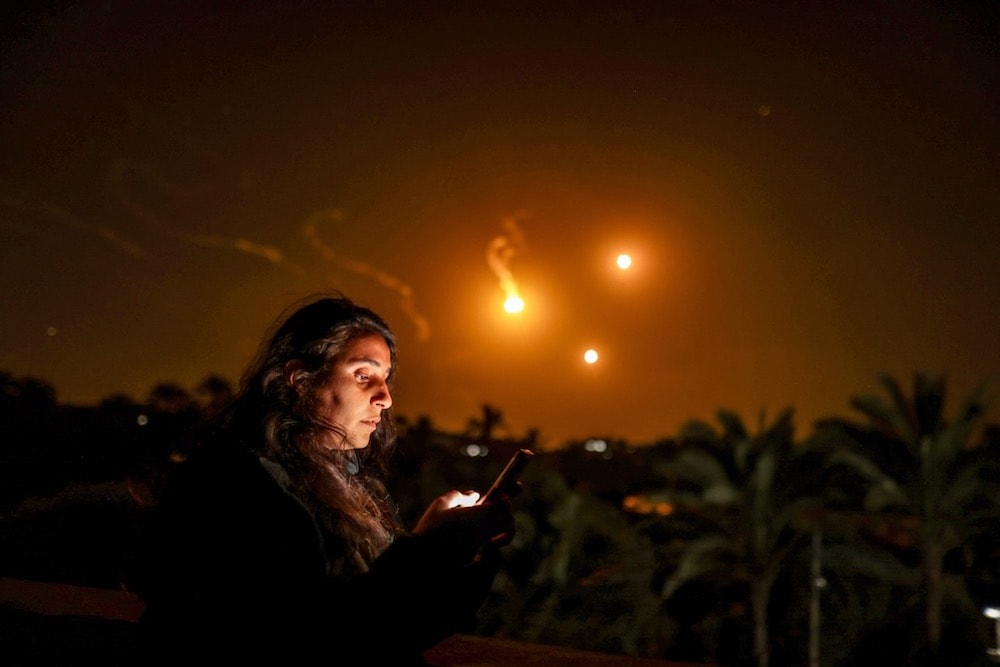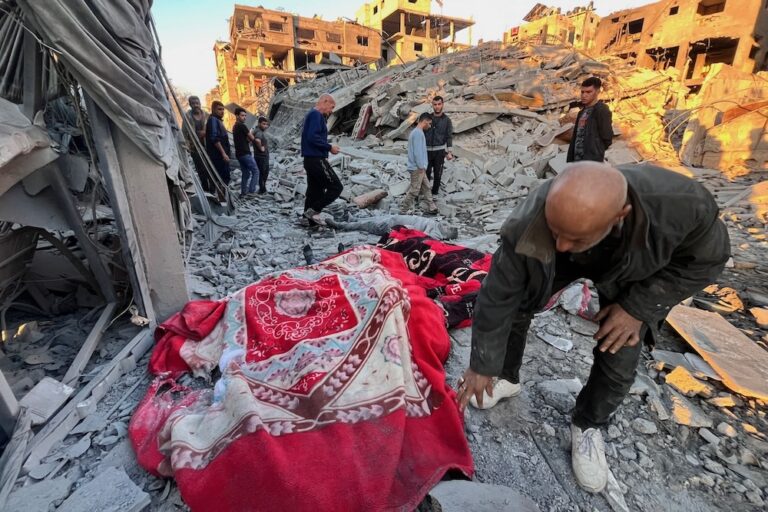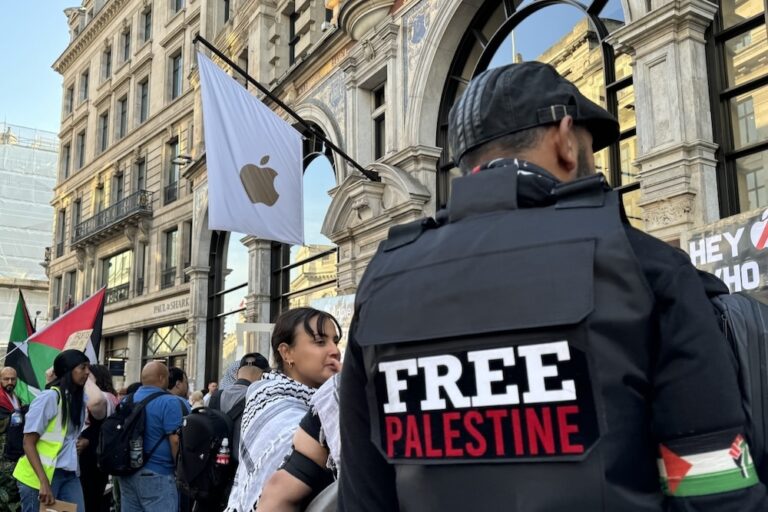CPJ speaks to three women journalists working tirelessly across borders to support Gaza's embattled press corps.
This statement was originally published on cpj.org on 3 April 2024.
New York-based Hoda Osman has spent the past six months helping Gaza journalists replace cameras, laptops, and phones lost or damaged in the Israel-Gaza war. More than 5,500 miles away, in the occupied West Bank city of Ramallah, Wafa’ Abdel Rahman coordinates humanitarian supplies and cash assistance for reporters under Israeli bombardment, while Rania Khayyat, also in Ramallah, is in constant contact with dozens of Gaza journalists to understand their needs.
Together, these three women play a central role in the difficult task of supporting Gaza’s press corps at a time of unprecedented strife and loss amid Israeli attacks and restrictions on basic supplies. At least 95 journalists and media workers have been killed since the war began on October 7. The vast majority of these fatalities are Palestinians killed in Israeli airstrikes; Israeli forces also killed three Lebanese journalists and two Israelis were killed by Hamas. With international journalists blocked from entering Gaza, the responsibility of covering the war falls on those who are living through it.
Osman, executive editor of Arab Reporters for Investigative Journalism, Khayyat, communications officer at the Palestinian Journalists’ Syndicate, and Rahman, the founder and director of the women- and youth-focused Palestinian NGO Filastiniyat, are committed to helping Gaza journalists survive and continue to report. Collectively, they have provided aid to hundreds of journalists on the ground. (CPJ recently supported these three groups with a $300,000 grant in emergency funds.)
CPJ spoke with Osman, Rahman, and Khayyat in separate phone calls about the day-to-day reality for journalists in Gaza and the challenges with providing aid in wartime. The interviews have been edited for length and clarity.
Hoda Osman, executive editor of Arab Reporters for Investigative Journalism
What are you hearing from journalists on the ground?
The day-to-day includes a lot of uncertainty and unpredictability. They have a home today, they might not have a home tomorrow. They have their family members with them today, they might lose them tomorrow. They themselves are alive today, they might be injured or killed tomorrow. Almost all the journalists we know have lost someone. The recent Israeli air strike on the hospital in Deir el Balah, where several journalists were injured, was a potent reminder of how things could change any day.
Almost all the journalists we know have been displaced, many of them have more than once, and many of them are living in tents. They have lost a lot of weight and it’s visible in pictures. Finding food and water is a daily challenge, especially in the north [where the international community warns of a famine]. One of the journalists told me he reports stories of people facing hunger when he himself is hungry. Using the bathroom is extremely difficult; imagine having to stand in line for hours to use the bathroom. One journalist told me they limit how much they drink so they wouldn’t need to use the bathroom frequently. These journalists are covering this war while facing this humanitarian crisis that everyone in Gaza is facing right now.
There are also work-related challenges. There is no protective gear in Gaza, except what was already there. Transportation due to fuel shortages is difficult, so moving from place to place to report is a problem. One journalist was jokingly telling me that donkey and horsecarts have now become the norm. Another journalist I know walks several kilometers every morning from their tent to the hospital where they work and walks back at the end of the day.
Then there are communications: How do you work as a journalist without power or connectivity? It’s a huge challenge to charge phones or other devices. A couple of journalists we know had their phones stolen because they were charging them in public places. Many journalists left their equipment when they left their homes, and they end up losing work because they have nothing to use to report. I can’t tell you how many journalists tell me they’re using their mother’s phone; some journalists write and file stories on their nieces’ phones. They’re not high-quality phones. They do everything on one device, if they’re lucky to have one. They record, they edit, they take pictures, they write, and they file. They get very little rest and they work constantly.
What type of support are you giving to journalists in Gaza?
Our focus from the start has been on replacing the lost or damaged equipment, allowing journalists to continue working and providing for themselves and their families. It also gives them a purpose: It helps to continue to work. We had to adapt constantly to the changing situation and where the journalists were. They kept moving south, so we changed our operations to be able to provide what they needed, wherever they were. We also provided humanitarian assistance like tents, mattresses and covers, clothes, and toiletries. We set up a couple of common working areas that are equipped with solar panels, chairs, tables, and internet connectivity. So far, we’ve assisted 150 journalists with both humanitarian assistance and equipment replacement.
[ … ]
Rania Khayyat, communications officer of the Palestinian Journalists’ Syndicate
What are you hearing from the journalists you’re supporting about their daily lives?
They are under threat and used to living with the voice of the drones in the sky the whole time. They are used to expecting any explosion at any time. Outside of [the southern Gaza city] Rafah, it’s very dangerous. They really expect to die daily. Every time you call them, they always tell us the same sentence, it may be their “last call.” When you call them, you feel like you’re in a nightmare.
We’re not always able to communicate with people in north Gaza, and we’re happy if we can get a line with them. It is impossible to get money to journalists in the north. Many of them want to move to Rafah, but they have family members who are disabled, they cannot move. It’s a personal decision. They stay in danger. There are about 150 journalists who remain in north Gaza.
[ … ]
Wafa’ Abdel Rahman, founder and director of Filastiniyat
What can you tell us about the reality on the ground for Gaza’s journalists?
There is a difference between the journalists who are based in the north of Gaza — Jabalia, Gaza City, Beit Hanoun — a different reality for those in the middle, and another different reality in the south. When it comes to the north, it’s worse because you have the famine. It’s not just the bombardment, it’s the lack of food, water, and medicine.
These are not journalists who have been deployed to Gaza, and it’s not their choice to be there. This looks very tough when talking about women journalists: Everyone is expecting them to take care of the family, to maintain the family, to cook for the family. The majority want to continue reporting, while at the same time taking care of their families.
Can you talk about the importance of journalists being able to continue reporting on this war?
First, there is nobody else [to report], and we need to put more pressure on letting international media in. Second, which is no less important: With the bombardment of the main human rights organizations and [reports of] the targeting of their field workers, whether they like it or not the journalists become human rights defenders. Journalists are the ones who are documenting the crimes. They are our eyes and ears on the ground. They’re the voices of those who are killed and those who are still surviving. We need them.
[ … ]



